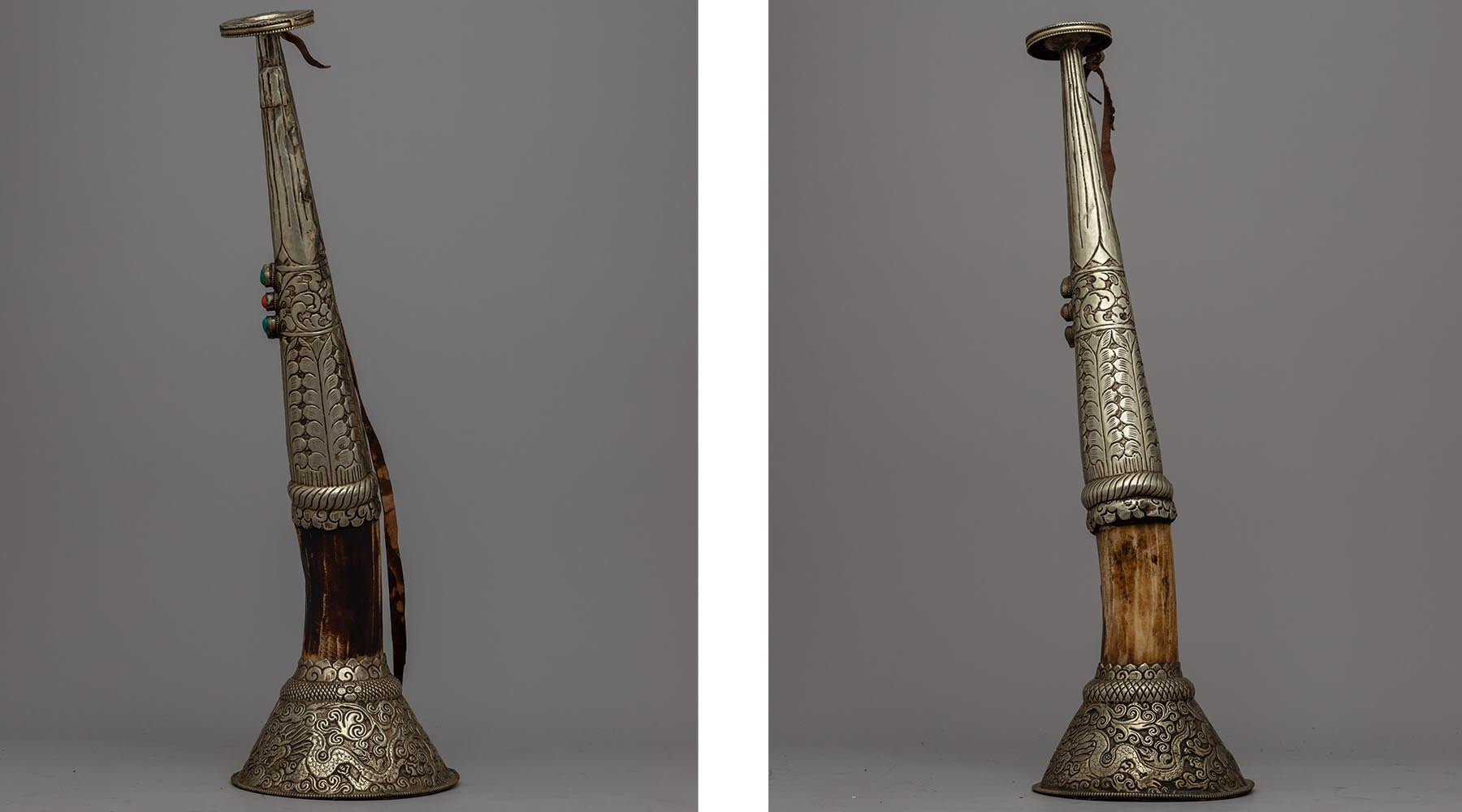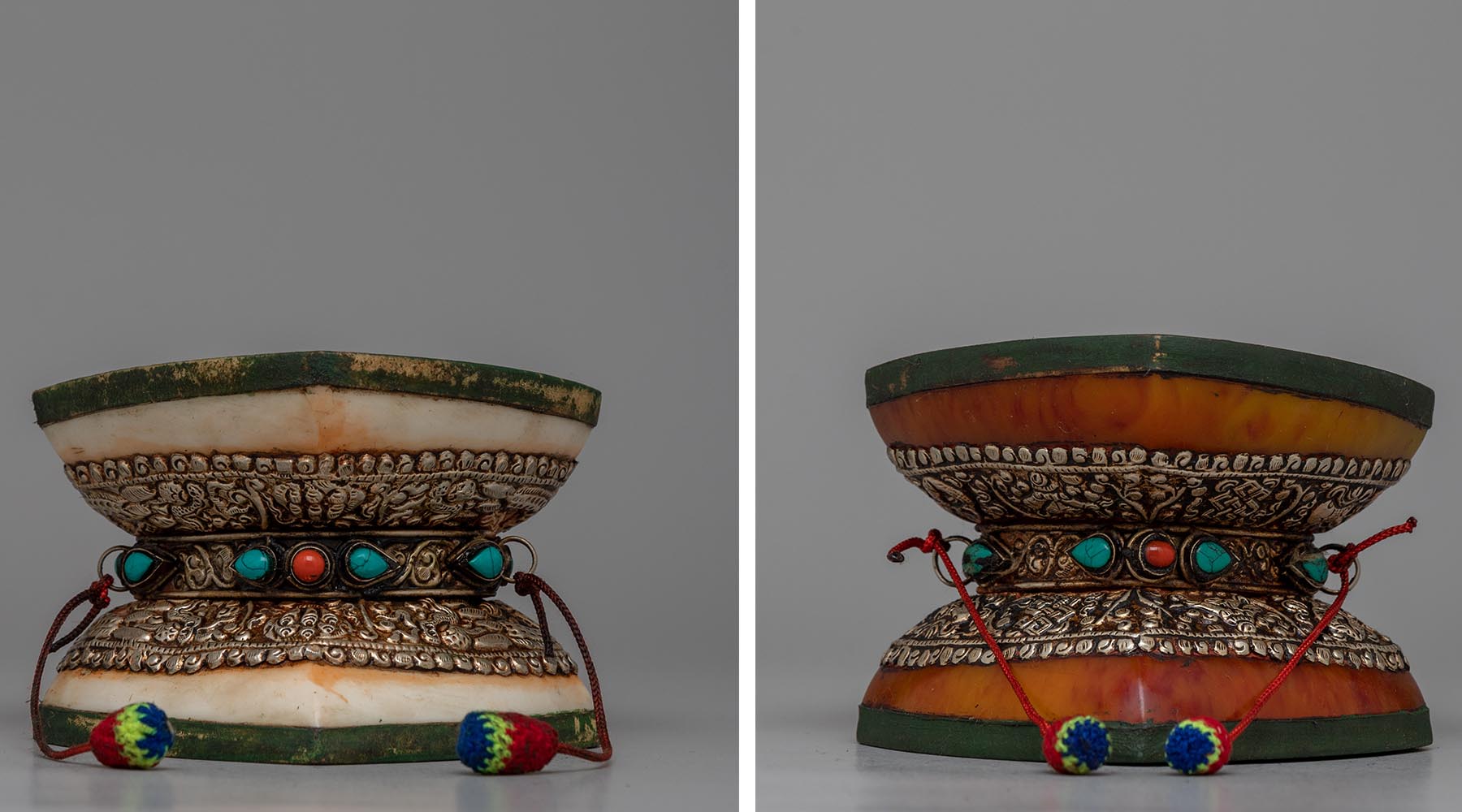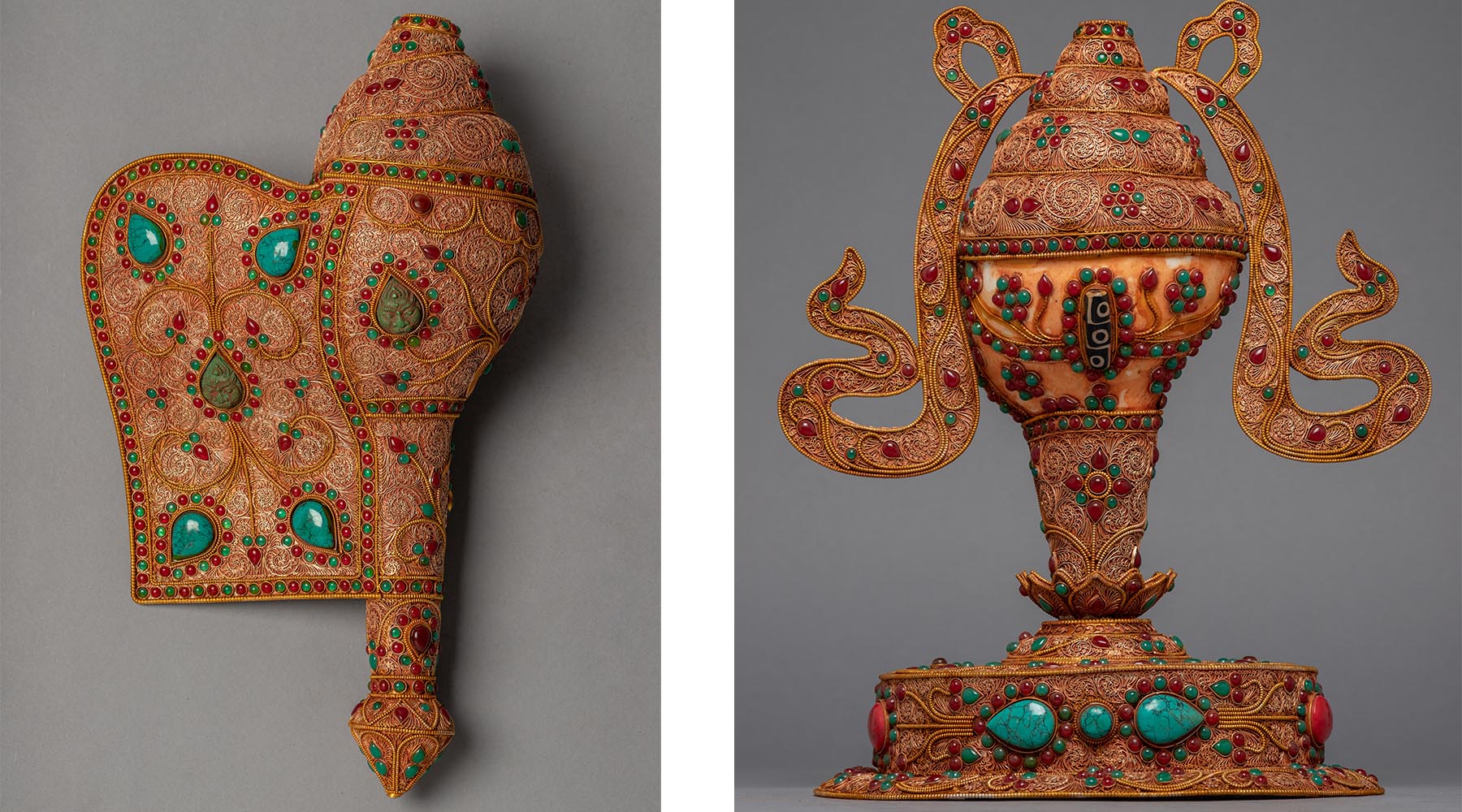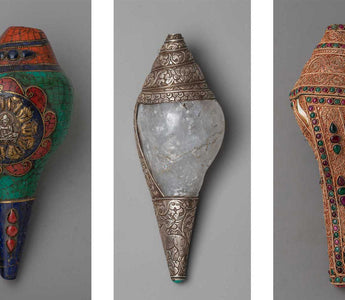The Hidden Beauty of Tibetan Musical Instruments Explored
Tibetan musical instruments hold an unparalleled historical significance, weaving a narrative that intertwines with the cultural fabric of the region. Each instrument carries a tale of antiquity, reflecting the dynamic evolution of Tibetan society through the ages.
“Let passionate melodies, damaru, and cymbals resound throughout the sky, the earth, and everything in between! .. Bright music, akin to the sound of a thousand thunderclaps, is offered to the Protectors of Religion and their adherents to make them happy.”
- Singing Bowls
- Chod Kangling
- Gyaling
- Dramyin (Dranyen)
- Damaru Drum
- Sankha (Conch Shell)
- Tibetan Bell
Ancient Roots and Cultural Exchange
The historical roots of Tibetan musical instruments are deeply ingrained in the ancient traditions of the Tibetan people. The demand for musical expression increased along with the prosperity of nomadic communities throughout the enormous Himalayan landscapes. The instruments became essential to many aspects of Tibetan life, including communal festivities and religious rites.
Furthermore, the cultural exchanges that took place along the historic Silk Road add to the historical significance of Tibetan musical instruments. The Tibetan repertoire contains a wide range of musical elements that have been influenced by neighboring regions like China, India, and Nepal. This combination enhanced the auditory experience while demonstrating the cultural connectivity of the Himalayan region.
Significance of Tibetan Musical Instruments
The significance of Tibetan musical instruments in religious rites and monastic practices lies at the heart of their historical legacy. Nestled among towering peaks, the monasteries evolved into sanctuaries where music was a vital means of expressing spirituality and devotion. Mantra chanting combined with musical resonance served as a medium for communicating with the divine.
This bond is represented by the Dungchen, a holy trumpet played during monastic rites. Made of brass or copper, its elongated shape symbolizes the spiritual ascension that practitioners pursue during ritualistic performances. The Dungchen's historical significance has left a lasting impression on Tibet's spiritual landscape, serving as a symbol of steadfast religious devotion throughout history.
Singing Bowls: Ancient Sound Healing

The art of playing singing bowls stands out as a captivating haven of calm and serenity in a world full of bustling noise and chaos. Often referred to as Tibetan or Himalayan singing bowls, these entrancing instruments can uplift our emotions, induce deep mindfulness, and even aid in healing.
We will go deeper into the realm of singing bowl playing, examining the methods, the therapeutic benefits, and the spiritual connection that elevates singing bowl playing to the status of a true art form.
In Tibetan rituals and ceremonies, singing bowls are an essential component, both in monastic contexts and in everyday spiritual practices. Chanting and meditation are accompanied by reverberating tones, which heighten the sacred atmosphere. The bowls are frequently passed from hand to hand during ceremonies, with the sounds they make conveying blessings and good intentions.
How to play singing bowls
- Place the bowl on the palm or soft padded cushion
- With the mallet in one hand, balance the bowl in place while holding the cushion in the other hand.
- Gently tap the mallet to the outside and inside edges of the bowl or play it around the rim.
- The resonant sounds and deep vibrations will fill and calm your soul.
Chod Kangling: Ritual of Liberation

Knagling is translated as "leg" (kang) or "flute" (ling), Kangling (Wylie: rkang-gling). Kangling is also known as bone trumpet. A trumpet fashioned from a human thigh bone is called a "chod kangling." Through the fearless gesture of playing the kangling, motivated by compassion, the practitioner of Tantric Chöd calls forth hungry spirits and demons to satisfy their hunger and ease their suffering.
Kangling are, worn by the deities described in tantric liturgies, also appeared in the great monasteries of the time, used for both their profound symbolic meaning, and as objects possessing inherent spiritual power. The trumpet is an essential component of the Chod practice, which is frequently connected to Avalokiteshvara, the Bodhisattva of Compassion.
However, it is not directly linked to any one deity. The use of the Kangling in the Chod context is consistent with the larger Buddhist concepts of impermanence, detachment, and the transformational power of spiritual practices.
The Kangling is an effective tool for slicing through attachment and ego in tantric rituals and Chod ceremonies. It is thought that the eerie tones created by the Kangling connect with the attachments and anxieties that people are trying to let go of on their spiritual path.
Gyaling: The Monk Flute
Gyaling means the Monk Flute. It is a double-reed instrument with a tone that is distinctly nasal and a narrower bore than the Chinese suona horn.
Buddhist ceremonies have included the resonant sound of the gyaling, a traditional Tibetan wind instrument, for centuries. Its haunting tones enhance the hallowed ambiance of monasteries and temples by evoking a sense of spirituality and ritual.
How to Play:
- To play a gyaling requires a technique called circular breathing, in which the instrument will constantly be emitting a linear sound, even while the musician inhales.
- The reed is fully submerged in the player’s mouth but does not touch it; the lips are pressed against the flat metal channel below the reed.
- A gyaling player tunes the instrument with the breath. The way of playing a gyaling varies depending on the lineage and ritual.
Dramyin Music: Soulful Strings
The dramyin is also known as ‘dranyen’. It is a Himalayan Folk Music lute with six strings. This is mostly used in Bhutan's Drukpa Buddhist culture and society, as well as in Tibet, Ladakh, Sikkim, and Himalayan West Bengal, as a background to singing. It is frequently utilized during Tibetan Buddhist religious festivals mainly on ‘Tshechu’.
The instrument can be played by plucking, fingerpicking, or strumming. The dramyin can be tuned as guitar ‘ g G c' c c f f ’.
People Play Dramyin to :
- Using dramyin songs to convey sentimentality for one's hometown.
- Utilizing lyrics to depict emotions and landscapes.
- Expressing gratitude and respect for parents through dramyin.
- Utilizing music to communicate personal life experiences.
- Expressing in Dramyin songs both happiness and difficulties.
- Singing with dramyin transforms into a form of cultural and emotional expression beyond music.
- Aids in the maintenance of Tibetan identity and the strengthening of community ties.
Damaru Drum: Drum of Tantric Wisdom
“In the mystic rhythm of the damaru's beat,
Cosmic echoes dance a sacred heartbeat.”

Click here to view our Tibetan Damaru
In both Buddhism and Hinduism, the damaru, a tiny two-headed drum, has great cultural and spiritual significance. Its connection to these traditions is a symbol of harmony, rhythm, and cosmic resonance that cuts across religious lines. The Damaru is also known as (Sanskrit: डमरु and Tibetan: Chod Drum).
One of the main gods in Hinduism, Lord Shiva, is frequently shown holding a damaru. It is believed to represent the cosmic sound or vibration that created and sustains the universe.
It is believed that the Sanskrit language was recognized by the drumbeats of the damaru.The dualities of existence, such as life and death, creation and destruction, and the cyclical nature of time, are represented by the two heads of the drum. The damaru is often depicted in the hands of Shiva during the Tandava dance.
The damaru is also connected to several gods and enlightened beings in Buddhism. For instance, a Buddhist Damaru is frequently shown in depictions of the celestial female beings known as dakinis in Tibetan Buddhism. The transcendence of dualities and the awakening of spiritual consciousness are believed to be symbolized by the sound of the drum. The essence of wisdom is believed to resonate with the sound of the drum, symbolizing the teachings of the Buddha.
How to Play
- Learn the correct way to grip the drumstick and the fundamental single and double strokes first.
- Regular practice of drum rudiments can enhance stick control and coordination.
- To strengthen your sense of rhythm and timing, use a metronome.
Sankha (Conch Shell): Resounding Triumph of Spirit

Click here to view our Conch Shell Collection
Sankha is connected to the Hindu and Buddhist. According to Hindu mythology, the sankha is associated with various deities, most notably Lord Vishnu. One popular legend describes the churning of the ocean (Samudra Manthan), during which a conch shell appeared as one of the divine gifts. The sankha is a musical instrument used in Hindu rituals and ceremonies that represents purity and auspiciousness.
In Buddhism, the conch shell is also revered as a sacred symbol representing the Buddha's teachings. It is one of the eight auspicious symbols of Tibetan Buddhism. The origin of the sankha, therefore, is deeply rooted in religious and mythological narratives, and its significance varies across different cultures and traditions.
Significance Of sankha
- The sound of the conch is considered a symbol of the deep and far-reaching resonance of the Buddha's teachings.
- The conch shell is used to summon practitioners together for prayers, ceremonies, or meditation sessions.
- The Sankha is frequently depicted as being held by deities or in symbolic representations of Buddhist art.
- Conch shells are occasionally used as sacred offerings in Buddhist rituals, representing the sincerity and purity of the practitioner's intentions.
Tibetan Bell: Bell of Awakening

Set out on a journey to discover the profound significance of bells in Buddhist traditions, and how their melodious chimes contribute to the sacredness of spiritual spaces. Explore the sonic spirituality embedded in the use of bells, and learn how their resonant tones enhance the spiritual ambiance in Buddhist practices.
In many Buddhist traditions, ringing bells not only draw people's attention but also remind them of the power of compassion and the possibility of liberation. Buddhist Bells may be used as sacred objects in Buddhist rituals. The act of offering represents the practitioner's devotion and commitment to the Buddhist path.
Importance of Bell:
- The sound of the bell is considered purifying and is thought to dispel negative energies.
- The bell's clear and resonant sound aids practitioners' concentration during meditation sessions.
- In Buddhist temples, bells may be rung at specific times, signaling the beginning or end of prayer sessions or other activities.
- Bells are offered as sacred objects in Buddhist rituals.










